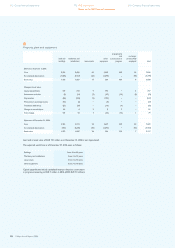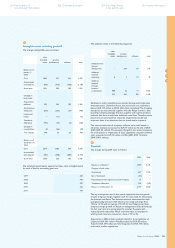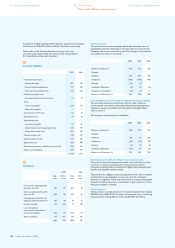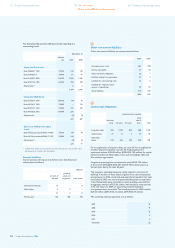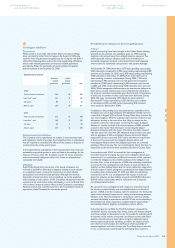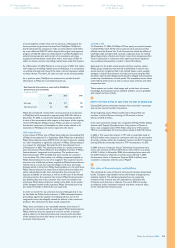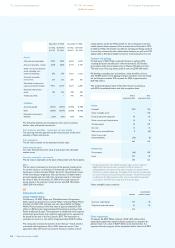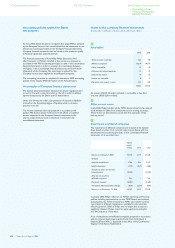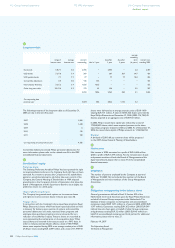Philips 2006 Annual Report Download - page 213
Download and view the complete annual report
Please find page 213 of the 2006 Philips annual report below. You can navigate through the pages in the report by either clicking on the pages listed below, or by using the keyword search tool below to find specific information within the annual report.
Philips Annual Report 2006 213
5555
5656
57
Contingent liabilities
Guarantees
Philips’ policy is to provide only written letters of support; Philips
does not stand by other forms of support. At the end of 2006, the
total fair value of guarantees recognized by the Company was EUR 4
million. The following table outlines the total outstanding off-balance
sheet credit-related guarantees and business-related guarantees
provided by Philips for the benefi t of unconsolidated companies
and third parties as at December 31, 2006.
Expiration per period
business-
related
guarantees
credit-
related
guarantees total
2006
Total amounts committed 466 42 508
Less than 1 year 151 14 165
2-5 years 80 2 82
After 5 years 235 26 261
2005
Total amounts committed 512 57 569
Less than 1 year 148 13 161
2-5 years 87 2 89
After 5 years 277 42 319
Environmental remediation
The Company and its subsidiaries are subject to environmental laws
and regulations. Under these laws, the Company and/or its subsidiaries
may be required to remediate the effects of the release or disposal of
certain chemicals on the environment.
In the United States, subsidiaries of the Company have been named as
potentially responsible parties in state and federal proceedings for the
clean-up of various sites. The Company accrues for losses associated
with environmental obligations when such losses are probable and
reasonably estimatable.
Litigation
Royal Philips Electronics and certain of its Group companies are
involved as plaintiff or defendant in litigation relating to such matters
as competition issues, commercial transactions, product liability,
participations and environmental pollution. Although the ultimate
disposition of asserted claims and proceedings cannot be predicted
with certainty, it is the opinion of the Company’s management that the
outcome of any such claims, either individually or on a combined basis,
will not have a material adverse effect on the Company’s consolidated
fi nancial position, but could be material to the consolidated results of
operations of the Company for a particular period.
5757
Provided below are disclosures of the more signifi cant cases:
Asbestos
Judicial proceedings have been brought in the United States, relating
primarily to the activities of a subsidiary prior to 1981, involving
allegations of personal injury from alleged asbestos exposure. The
claims generally relate to asbestos used in the manufacture of
unrelated companies’ products in the United States and frequently
involve claims for substantial compensatory and punitive damages.
At December 31, 2006, there were 4,370 cases pending, representing
9,020 claimants (compared to 3,984 cases pending, representing 8,082
claimants at December 31, 2005, and 2,909 cases pending, representing
6,028 claimants at December 31, 2004). Most of the claims are in
cases involving a number of defendants. During 2006, 1,140 cases,
representing 2,930 claimants, were served against the Company’s
subsidiaries (2,052 cases, representing 3,283 claimants, were served
in 2005, and 2,436 cases, representing 4,085 claimants were served in
2004). While management believes there are meritorious defenses to
these claims, certain of these cases were settled by the subsidiaries
for amounts considered reasonable given the facts and circumstances
of each case. A number of other cases have been dismissed. During
2006, 754 cases, representing 1,992 claimants, were settled or
dismissed (977 cases, representing 1,229 claimants, were settled
or dismissed in 2005, and 608 cases, representing 810 claimants,
were settled or dismissed in 2004).
In addition to the pending cases discussed above, a subsidiary of the
Company was one of approximately 160 defendants initially named in
a case fi led in August 1995 in Morris County, Texas. Since the time the
case was brought in 1995, the subsidiary had not been involved in any
substantive activity in the case other than fi ling an answer to the
complaint and had no information concerning the types of alleged
diseases or injuries involved. In the fourth quarter of 2005, plaintiffs’
counsel in this matter fi led information concerning the alleged
diseases and injuries with the Court. The claims have been severed
into four cases: one case with 281 malignant disease claims; two cases
with an aggregate of 222 nonmalignant disease claims with alleged
impairment; and one case with 3,167 claims that have no impairment
at this time. The cases with the malignant disease claims and
nonmalignant disease claims with alleged impairment are currently
pending in Morris County. The case containing the claims that have no
impairment at this time has been transferred to Harris County, Texas.
In accordance with IAS 37, an accrual for loss contingencies is
recorded when the Company has incurred an obligation based upon
a past event, if it is probable an outfl ow of resources will be required
to settle the obligation, and a reliable estimate of the obligation can
be made. Prior to the third quarter of 2006, this subsidiary established
an accrual for loss contingencies with respect to asserted claims for
asbestos product liability based upon its recent settlement experience
of similar types of claims, taking into consideration the alleged illnesses
in pending cases. At December 31, 2005 and 2004, the subsidiary’s
recorded accrual for loss contingencies with respect to asserted
claims for asbestos product liability amounted to EUR 88 million and
EUR 83 million, respectively, which is refl ected in the Company’s
consolidated balance sheet.
An accrual for loss contingencies with respect to unasserted claims
for asbestos product liability was not established prior to the third
quarter of 2006 since the Company, with the assistance of a third party
expert with substantial experience in valuing and forecasting asbestos
liabilities (“the Third Party Expert”), concluded it could not reliably
estimate this liability in accordance with IAS 37 due to the subsidiary’s
limited historical claims experience coupled with the uncertainties
surrounding asbestos litigation and legislative reform efforts.
In the third quarter of 2006, the Third Party Expert reviewed the
subsidiary’s history of, among other things, claims and diseases alleged,
and claims settled or dismissed in order to provide the subsidiary with
an estimate of the volume, timing and cost of both current and future
asbestos-related personal injury claims. In light of additional claims
history experienced by the subsidiary, as well as the impact of state
tort reform in several states, the clarifi cation of the possibility of
national legislation and other factors, the Third Party Expert was able
to use a conventional methodology for estimating future asbestos-
226 Corporate governance224 Reconciliation of
non-US GAAP information
234 The Philips Group
in the last ten years
236 Investor information



